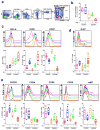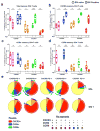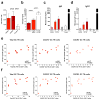Induction of Th1-Biased T Follicular Helper (Tfh) Cells in Lymphoid Tissues during Chronic Simian Immunodeficiency Virus Infection Defines Functionally Distinct Germinal Center Tfh Cells
- PMID: 27481845
- PMCID: PMC4992610
- DOI: 10.4049/jimmunol.1600143
Induction of Th1-Biased T Follicular Helper (Tfh) Cells in Lymphoid Tissues during Chronic Simian Immunodeficiency Virus Infection Defines Functionally Distinct Germinal Center Tfh Cells
Abstract
Chronic HIV infection is associated with accumulation of germinal center (GC) T follicular helper (Tfh) cells in the lymphoid tissue. The GC Tfh cells can be heterogeneous based on the expression of chemokine receptors associated with T helper lineages, such as CXCR3 (Th1), CCR4 (Th2), and CCR6 (Th17). However, the heterogeneous nature of GC Tfh cells in the lymphoid tissue and its association with viral persistence and Ab production during chronic SIV/HIV infection are not known. To address this, we characterized the expression of CXCR3, CCR4, and CCR6 on GC Tfh cells in lymph nodes following SIVmac251 infection in rhesus macaques. In SIV-naive rhesus macaques, only a small fraction of GC Tfh cells expressed CXCR3, CCR4, and CCR6. However, during chronic SIV infection, the majority of GC Tfh cells expressed CXCR3, whereas the proportion of CCR4(+) cells did not change, and CCR6(+) cells decreased. CXCR3(+), but not CXCR3(-), GC Tfh cells produced IFN-γ (Th1 cytokine) and IL-21 (Tfh cytokine), whereas both subsets expressed CD40L following stimulation. Immunohistochemistry analysis demonstrated an accumulation of CD4(+)IFN-γ(+) T cells within the hyperplastic follicles during chronic SIV infection. CXCR3(+) GC Tfh cells also expressed higher levels of ICOS, CCR5, and α4β7 and contained more copies of SIV DNA compared with CXCR3(-) GC Tfh cells. However, CXCR3(+) and CXCR3(-) GC Tfh cells delivered help to B cells in vitro for production of IgG. These data demonstrate that chronic SIV infection promotes expansion of Th1-biased GC Tfh cells, which are phenotypically and functionally distinct from conventional GC Tfh cells and contribute to hypergammaglobulinemia and viral reservoirs.
Copyright © 2016 by The American Association of Immunologists, Inc.
Figures





References
-
- Sallusto F, Geginat J, Lanzavecchia A. Central memory and effector memory T cell subsets: function, generation, and maintenance. Annual review of immunology. 2004;22:745–763. - PubMed
MeSH terms
Substances
Grants and funding
LinkOut - more resources
Full Text Sources
Other Literature Sources
Research Materials
Miscellaneous

